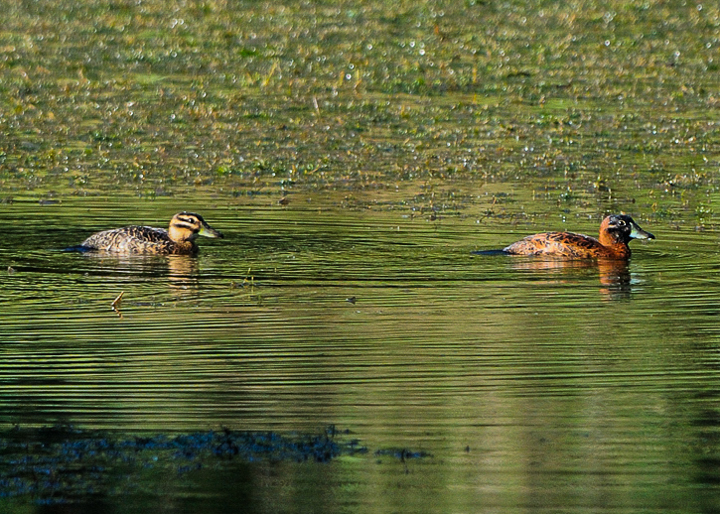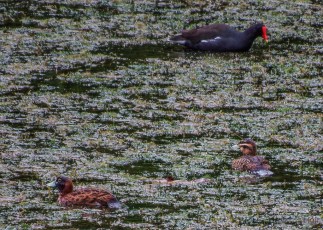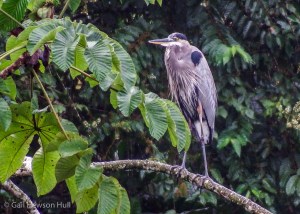A Secretive Nomad: The Masked Duck

A male Masked Duck with an injured foot joined a male Common basilisk lizard lakeside at Finca Cantaros in Linda Vista de San Vito, Costa Rica
Sometimes they arrive at our marshy pond at Finca Cántaros in late January, sometimes in February, and this year some individuals came in both March and April. These highly unpredictable fowl are the Masked Duck. They stay a few weeks or a few months. In the literature, these small ducks are called vagrants, erratics or nomads at the margins of their range. They are not considered migratory, and their unpredictability depends on prospects for food and water. They are stifftails—ducks with long, spiky tails that were described and named Oxyura dominicus in 1766 by Carl Linnaeus, the “Father of Taxonomy”. In 1880 American ornithologist Robert Ridgeway determined Oxyura dominicus was different enough from its closest relative, Oxyura jamaicensis, the Ruddy Duck, that it should have its own genus. The handsome Masked Duck is now known as Nomonyx dominicus.
Such a long history, but in 2015, much is still unknown about the Masked Duck in the Anatidae family of ducks, geese and swans.
Though the Masked Duck has a wide range in the Neotropics, they are considered scarce in all locations. Inhabiting small lakes with marshes, freshwater mangrove lagoons, and even rice fields from northern Argentina through South America, Central America, and the Caribbean to North America, they don’t gather in large groups to reproduce. The only occasional breeding and nesting locations actually documented have been on the Gulf Coast of Texas and in Barbados. We learned from the San Vito Bird Club that the only sighting of the Masked Duck in southern Costa Rica this year has been on our own Laguna Zoncho at Finca Cantaros.

Laguna Zoncho, a wetland that attracts aquatic birds primarily in Costa Rica’s south Pacific dry season, December to April. The lake has been dated by sediment testing; maize pollen found is 3250 years old indicating people have lived around the lake for at least that long.
Because the Mask Duck is so rare, the president of the San Vito Bird Club reports their arrival at Finca Cantaros to eBird, an international repository for observations. Some birders come to our nature reserve just to see them.
The Masked Duck likes open water when diving and gleaning greens from our aquatic plant, Elodea, but is never far from marsh cover. When staying out of sight, they may behave like rails or like our White-throated Crake, making pathways or using preexisting tunnels in the grasses, foraging for seeds, roots, insects and small crustaceans. From what we observe they are shy upon first arrival, flying to the opposite side of the pond when people pass by on the lakeside trail, but they do slowly lose some of this skittishness if people are quiet.
In our summer (December through April) Elodea provides food not only for the Wolf ciclid, a lake bass, and for visiting Masked Duck, but also for Blue-winged Teal and Common and Purple Gallinule. Green Heron, Great Blue Heron, and the occasional Great Egret search for fish or insects at the edges of the pond, joined by Spotted Sandpiper, Ringed and Green Kingfisher at certain times of the year.
Data about Masked Duck is scarce. The habits of their young are termed “not well known.” The age of their first flight is “not well known.” Breeding habits are “not well known.” Their secretive behavior and nomadic wanderings make estimating their numbers difficult, so the website Partners in Flight in 2010 suggested their population was between “50,000 and 499,999” individuals. The largest number observed was about 3800 ducks on the Texas coast after heavy rains made temporary wetlands. Because their range is extremely wide, even if their numbers are diminishing due to hunting and habitat loss, they are not considered a Vulnerable species, but rather a species of Least Concern by the International Union of the Conservation of Nature (IUCN). Hunting for Masked Duck, and all wildlife, is illegal in Costa Rica. But Masked Duck hunting is legal in Texas, where hunters may bag up to six ducks per day. Hunting with dogs for Masked Duck was recorded in Cuba in 1923. Curious about why Masked Duck would be hunted, I searched the web for recipes but could only find in an International Dictionary of Food a reference to them as “highly prized” for the table.
In 2009 some Masked Duck arrived on January 26 and I made a note of it. Early in 2010, on my usual 6:15 am walk, I was on the lookout for the ducks. There were Gallinules on the lake, but no other aquatic birds. Continuing my walk to a hilltop overlooking the wetland, I suddenly heard loud splashes. Five Masked Duck had arrived together, exactly the same day as the year before! They soon curled up to rest, heads under wings. A few hours later, they were eating Elodea as if their lives depended on it. I felt unbridled optimism about life on earth. I don’t know where they come from or where they go when they leave, but may Masked Duck keep finding their way, and may someone always be here, long after I am gone, to wait for them.
References
According to Stiles & Skutch, Masked Duck are also “uncommon” in Costa Rica’s Valle Central, especially around Cartago; in Guanacaste’s Tempisque basin, and in the environs of Río Frío. A Guide to the Birds of Costa Rica by F. Gary Stiles and Alexander F. Skutch, illustrated by Dana Gardner, Comstock Publishing Associates, a Division of Cornell University Press, 1989, p. 95.
Garrigues and Dean call them “rare” from lowlands to 1500 meters. The Birds of Costa Rica, A Field Guide by Richard Garrigues and illustrated by Robert Dean; A Zona Tropical Publication from Comstock Publishing Associates, a division of Cornell University Press, Ithaca, New York, Second Edition, 2014, p. 36.
See also these websites: Audubon, Cornell Laboratory of Ornithology, and Ducks Unlimited.
My friend Marco Tulio Saborio, photographer of the Masked Duck pair above, is well known for his extraordinary photographs of the birds of Costa Rica, marine wildlife, and the biodiversity of the tropics. He can be reached by email at msaborio@conexion.cr






